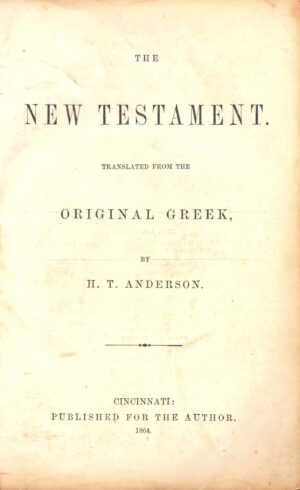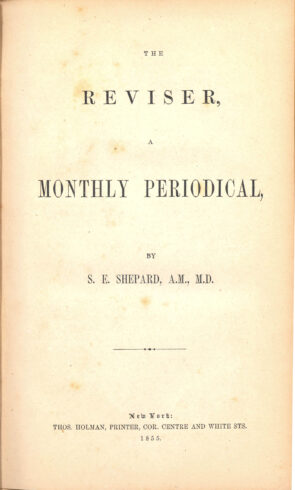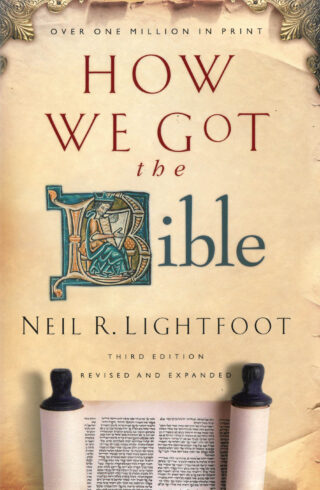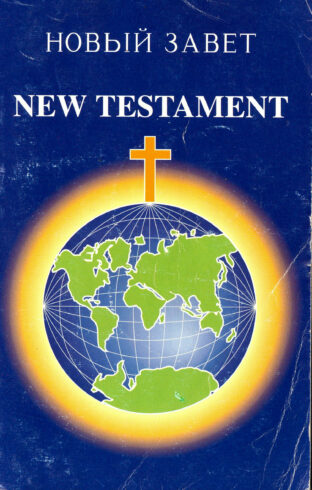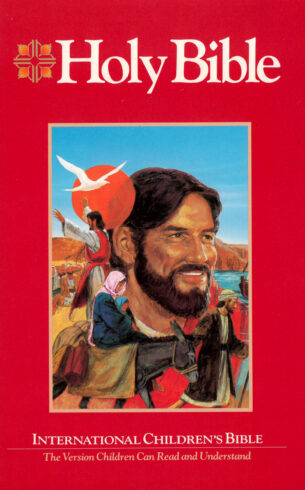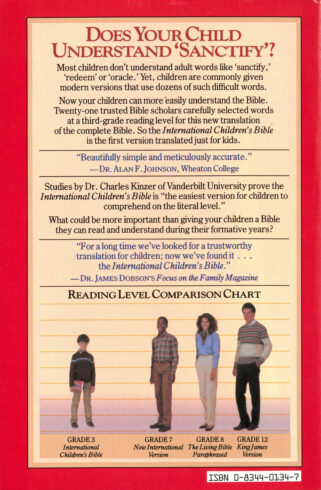“Holding Forth the Word of Life”: Bible Translation and Publication and the Stone-Campbell Movement
Introduction
Two slogans became rallying cries for the Stone-Campbell Movement for much of two centuries. Thomas Campbell coined the phrase ‘Where the Scriptures speak, we speak; where the Scriptures are silent, we are silent’ as a short-hand description of his aim for Christian faith and practice. In time those who supported his reform plea often described themselves with a second slogan: we are a ‘people of the Book.’
“We only aim at substituting the New Testament in lieu of every creed in existence; whether Mahometan, Pagan, Jewish, or Presbyterian” stated Alexander Campbell in 1823. Rather, “we neither advocate Calvinism, Arminianism, Arianism, Socinianism, Trinitarianism, Unitarianism, Deism, or Sectarianism, but New Testamentism.” Given how the text of English Bible constituted the center of gravity within the Campbell’s reform plea, one of the first literary efforts Alexander Campbell devoted himself to was a careful revision of the New Testament.
Of central importance to Alexander Campbell was the conviction that Christians should use Biblical terminology to describe Biblical concepts. Another slogan put it simply: ‘call Bible things by Bible names.’ For example, Campbell desired to reform the contemporary practice of Christian baptism to align with that of the earliest Christians. To that end he pointed out that the English term ‘baptism’ was in fact not a translation, but a transliteration from the Greek. The Greek term meant to immerse, which was not clearly evident in the English translations which had been in use for centuries.
Campbell’s work, though, was not wholly original. He drew upon the prior work of several British evangelical scholars who utilized underlying Greek texts superior to those available to the translators of the King James Bible. Working from Griesbach’s Greek testament, Campbell utilized the work of George Campbell, James Macknight, Philip Doddridge and Charles Thompson as a basis from which to further modify renderings, sentence construction, and phraseology.
To facilitate smoother reading and comprehension Campbell made two changes that were decades ahead of their time. He dropped the –eth endings on verbs and printed the text in a single column with chapter and verse numbers set in the margin. His work garnered
this praise from Luther Weigle, Chair of the Revised Standard Version Translation Committee, “Campbell was an indefatigable student of Greek, honest in dealing with it, and courageous in presenting its meaning. [Campbell’s work] has been proved valid by the testing of over a century of critical study.”
Alexander Campbell inaugurated a tradition of Biblical translation and publication among Christian Churches and Churches of Christ. Succeeding generations, each in their own way, perpetuated, modified, and expanded this trajectory as they held forth the Word of Life.
Sacred Writings of the Apostles and Evangelists of Jesus Christ, commonly styled the New Testament. Published and printed by Alexander Campbell. Third edition, 1832
First printed in 1826, it went through six American editions by 1839, four British editions between 1838-1852 and two Welsh editions in the 1840s. At least six publishers among Christian Churches and Churches of Christ periodically reissued it after Campbell’s death in 1866 until the present.

Campbell, Alexander, George Campbell, Philip Doddridge, and James Macknight. The Sacred Writings of the Apostles and Evangelists of Jesus Christ Commonly Called the New Testament: Translated from the Original Greek. Bethany, Brooke Co., Va: Alexander Campbell, 1832.
Sacred Writings of the Apostles and Evangelists of Jesus Christ, commonly styled the New Testament. Christian Publishing Company, St. Louis, stereotyped from the third edition, ca. 1899
Campbell knew that while most readers would not subscribe to his periodicals or hear his debates in person (or perhaps ever read them in print), they would read their New Testaments, and they would hear preaching in a congregation on Sundays. This pocket-sized testament, issued ca. 1899, is a testimony not only to its endurance in print, but to Campbell’s strategy to propagate his reform plea in a manner readily accessible to the most readers.

Campbell, Alexander, George Campbell, James Macknight, and Philip Doddridge. The Sacred Writings of the Apostles and Evangelists of Jesus Christ: Commonly Styled the New Testament. St. Louis: Christian Pub. Co, 1899.
H. T. Anderson, The New Testament. Translated from the Original Greek, 1864
Henry Tompkins Anderson was one of a handful of Disciples who published editions of the New Testament in the 19th century. He worked directly from a Greek Testament, rather
than any existing version, “to express the exact sense of the Original, without permitting himself to be confined to an imitation of the letter of the Greek.” In this way he anticipated
the dynamic equivalence theory of Biblical translation employed in across the evangelical spectrum in the later 20th century, from the New American Standard Bible to Good News for Modern Man and the New International Version.
Manuscript letter, Alexander Campbell to a ‘brother Abbot’, 27 February 1828. Facsimile.
In February 1828 Campbell was busy revising the first edition of the New Testament. In this poignant and articulate letter, he reveals his confidence in the potency of the printed word to “dispense blessing to millions.”
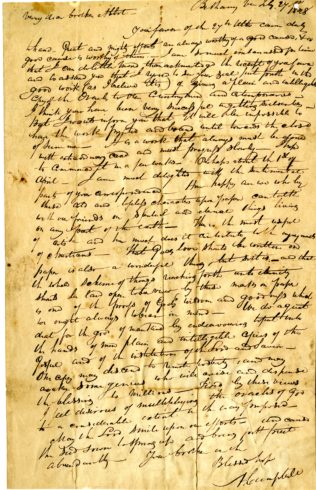
Alexander Campbell, autograph letter, 31.2 cm x 19.8 cm, folded, addressed on reverse to John Abbot, Macon, Georgia; postmarked “Free A Campbell P.M” from Bethany, Virginia, Feb. 28, 1828. Campbell replies to a letter from Abbot, who is selling prepublication subscriptions to the second edition of Campbell’s 1826 edition of the New Testament. Campbell describes the schedule for the new edition, and expresses wonder that God’s love should be written on paper.
The Reviser, A Monthly Periodical, edited by S. E. Shepard, 1855
Disciple S. E. Shepard edited, as a friend of the American Bible Union, this periodical as the only one of its kind “exclusively devoted to the work of Translation and Revision.” Shepard intended to “furnish instances of imperfection in King James’ revision and propose amendments”, promote critical study of existing modern language versions, and support all efforts toward their improvement.
B. W. Johnson, The People’s New Testament, Common and Revised Versions, with References and Colored Maps. With Explanatory Notes. One-volume editions, ca. 1970s
Barton Warren Johnson first issued this in two volumes in 1889 and 1891. He utilized the King James and the Revised Version in parallel columns, annotated them with cross-references, and paired them to a simple running commentary designed “not especially for the learned and critical class, but for the people.” ‘Johnson’s Notes’ quickly became a staple in the libraries of many across the Movement. The one-volume edition was small enough in size to be taken to church or Sunday School and remains in print.

Johnson, B. W. The People’s New Testament: The Common and Revised Versions, with References and Colored Maps, with Explanatory Notes. Delight, Ark: Gospel Light Pub. Co, 1950.

Johnson, B. W. The People’s New Testament: The Common and Revised Versions, with References and Colored Maps, with Explanatory Notes. Delight, Ark: Gospel Light Pub. Co, 1950.
[Alexander Campbell] Acts of the Apostles. Translated from the Greek, on the basis of the Common English Version. With Notes, 1858
Though a collection of his speeches and addresses was published late in Campbell’s life, and a compilation of his lectures was published posthumously, Campbell’s creative monographic publishing began and ended with the New Testament. This edition of Acts serves as both a critical translation and a commentary. Another Disciple, James Shannon, translated the Gospel of Luke for this series. Campbell was an active supporter of the American Bible Union and served as an officer in its national governing board of advisors. Other Disciples active in the organization included B. F. Hall, Tolbert Fanning, Jacob Creath, John T. Johnson, and
John R. Howard.
Simple English Bible (New Testament), 1980
This group of testaments illustrate how members of Churches of Christ utilized guided-study editions of the New Testament for evangelistic purposes. Notice the statements on the covers of each of these testaments. Each of these contains a sequenced guide to Bible study designed to bring a prospective convert to faith and baptism. The Way of Salvation New Testament, a second copy of which is displayed here opened to Acts 2, has red underlining and marginal notations and instructions to guide the reader through the sequenced study.
We Care Ministries New Testament Soul Winners’ Checkbook edition, 1990

Holy Bible: The New Testament. 1990.
Way of Salvation New Testament, ca. 1972

The New Testament of Our Lord and Savior Jesus Christ: Translated from the Original Greek and with the Former Translations Diligently Compared & Revised. Nashville, Tenn: Williams Printing, 1900.
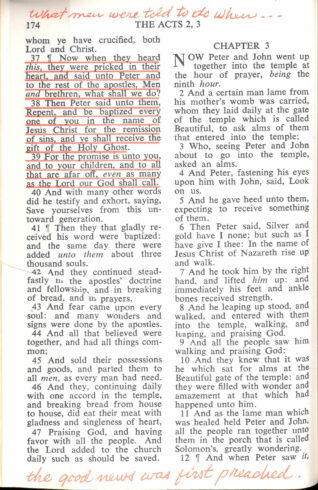
The New Testament of Our Lord and Savior Jesus Christ: Translated from the Original Greek and with the Former Translations Diligently Compared & Revised. Nashville, Tenn: Williams Printing, 1900.
The New Testament, World Bible School edition, 1975
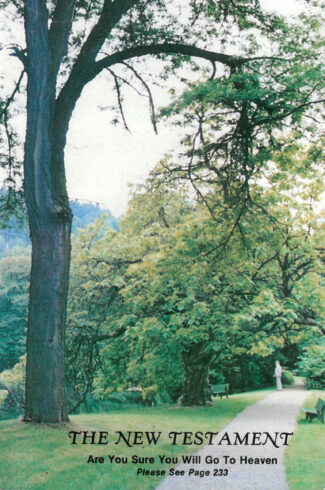
The New Covenant, Commonly Called the New Testament of Our Lord and Saviour Jesus Christ: Translated Out of the Greek, Being the Version Set Forth A.D. 1611, Compared with the Most Ancient Authorities and Revised A.D. 1881 : Newly Edited by the New Testament Members of the American Revision Committee, A.D. 1900. Dallas: Gospel Teachers Publications, 1975.
Neil Lightfoot, How We Got the Bible, third revised and expanded edition, seventh printing, 2009
Two scholars from Churches of Christ, Neil Lightfoot and Jack Lewis, made significant contributions to evangelical scholarship about Bible versions, translations, and their history with the publication of these books. Lightfoot’s work began as a booklet,
designed for adult Sunday School classes, published by Churches of Christ publisher R. B. Sweet. As this copy notes, through several revisions and expansions, it became a million-seller. Lewis’ book grew out of his work as professor of Bible at Harding College Graduate School of Religion (now Harding School of Theology) in Memphis. Both published by Baker Book House, these books gained wide global readership.
Jack P. Lewis, The English Bible from KJV to NIV, 1981

Lewis, Jack P. The English Bible, from KJV to NIV: A History and Evaluation. Grand Rapids, Mich: Baker Book House, 1981
Joseph Bryant Rotherham, The Emphasized Bible, A New Translation. Kregel Publications reprint edition, 1959
Rotherham, an influential leader of the Disciples in Great Britain, issued the first edition of his work in 1872, and though a series of revisions and editions, completed a new translation of the whole Bible by 1902. His work anticipated the work of the English and American Revision Committees, that resulted in the publication of the American Standard Version in 1901 and 1929. Rotherham first used Ginsburg’s critical Hebrew text and later Tregelles’ critical Greek text which availed itself of the newly discovered Sinaitic manuscripts. He later utilized the critical work of Westcott and Hort. The system of notation he devised, and the typography and arrangement of the text on the page, as illustrated here in Matthew 1, does not lend itself to leisurely reading. However, it is ideally suited for careful study and it proved successful, remaining in print for well over a century.
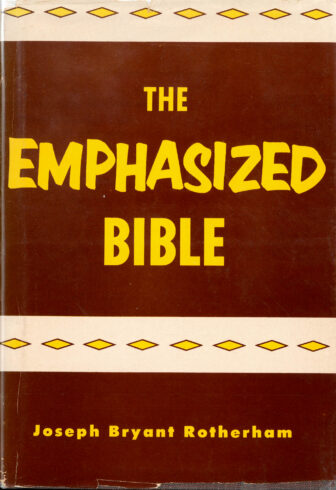
Rotherham, Joseph Bryant. The Emphasized Bible; A Translation Designed to Set Forth the Exact Meaning, the Proper Terminology and the Graphic Style of the Sacred Original. Grand Rapids, Mich: Kregel Publications, 1959.

Rotherham, Joseph Bryant. The Emphasized Bible; A Translation Designed to Set Forth the Exact Meaning, the Proper Terminology and the Graphic Style of the Sacred Original. Grand Rapids, Mich: Kregel Publications, 1959.
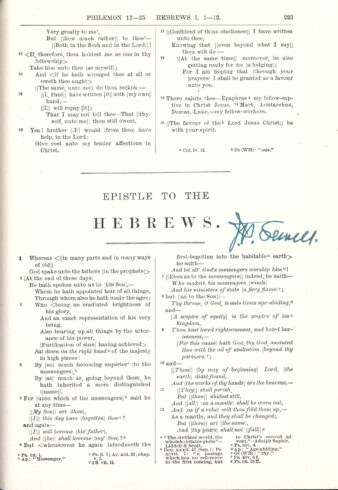
Rotherham, Joseph Bryant. The Emphasized Bible; A Translation Designed to Set Forth the Exact Meaning, the Proper Terminology and the Graphic Style of the Sacred Original. Grand Rapids, Mich: Kregel Publications, 1959.
[Parallel edition of Hugo McCord’s New Testament translation and the Russian Synod Version], 1988
These examples illustrate the global reach of hundreds of Churches of Christ missionaries who utilized translations produced in the United States. Hugo McCord (1911-2004) was a preacher, teacher, and professor at Oklahoma Christian University. World Bible Translation Center, publisher of the Easy to Read Version, is based in Fort Worth, Texas.
Nuevo Testamento [Spanish language edition of the Easy to Read Version New Testament], 2000
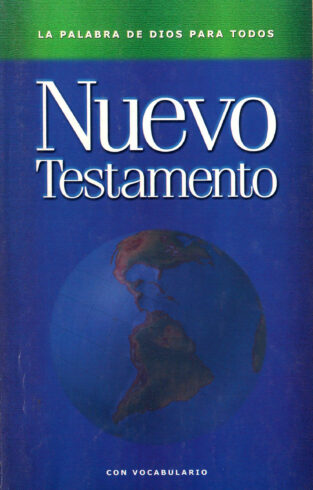
Centro Mundial de Traducción de la Biblia. Nuevo Testamento: con vocabulario : la palabra de Dios para todos. Fort Worth, Tex: Centro Mundial de Traducción de la Biblia, 2000.
D. A. Sommer, editor. Simplified New Testament, 1923
Daniel Austen Sommer continued in the trajectory initiated by B. W. Johnson a generation earlier. The Simplified New Testament is not an original translation, rather it is a carefully annotated edition of the King James version, with many supplemental notes, introductions, and comments. The copy displayed here is open to John 1 showing Sommer’s notes printed in lighter-face type.

Sommer, D. Austen. Simplified New Testament: Authorized Version. Indianapolis, Ind: “Simplified Bible” House, 1923.

Sommer, D. Austen. Simplified New Testament: Authorized Version. Indianapolis, Ind: “Simplified Bible” House, 1923.
Harold E. Monser, editor in chief. The Cross-Reference Bible, American Standard Version, with Topical Analysis and Cross References with Variorum Readings and Renderings. Baker Book House reprint edition, 1959
Monser (1868-1918), son of Disciples author and preacher J. W. Monser, led an interdenominational team of scholars to produce one of the most ambitious ‘study Bibles’ attempted. His associate editors were Disciples Charles Reign Scoville, D. R. Dungan, and J. W. Monser; they joined evangelicals Ira M. Price, A. T. Robertson, F. C. Eiselen, Milton S. Terry, R. A. Torrey, John R. Sampey, and Andrew C. Zenos to produce a work of 2400 pages containing over 100,000 cross-references, plus thousands of articles, notes, comments, and other study aids built around the American Standard Version. First published in 1910, the massive volume remained in print in the 1950s. In was revised in 1972 and re-published under the title Logos International Study Bible.

Monser, Harold E. The Cross-Reference Bible: American Standard Version. With Topical Analysis and Cross References, with Variorum Readings and Renderings. Grand Rapids: Baker Book House, 1959.

Monser, Harold E. The Cross-Reference Bible: American Standard Version. With Topical Analysis and Cross References, with Variorum Readings and Renderings. Grand Rapids: Baker Book House, 1959.
F. LaGard Smith. The Narrated Bible in Chronological Order, 1984
F. LaGard Smith, The Daily Bible, New International Version with Devotional Insights to Guide You Through God’s Word, 1999
This pair of books by LaGard Smith are not ‘study Bibles’ at least not in the vein of B. W. Johnson, D. A. Sommer, or Harold Monser. Rather, they are devotional and meditational. Smith worked from the New International Version, rearranged it in places, and commented upon it to assist the reader in reflecting upon the message of the Bible. He dedicated both books to his parents. His father, Frank Smith, preached among Churches of Christ and his mother, Mary Faye, was a formative influence on LaGard, who has taught and lectured at a number of Churches of Christ universities.
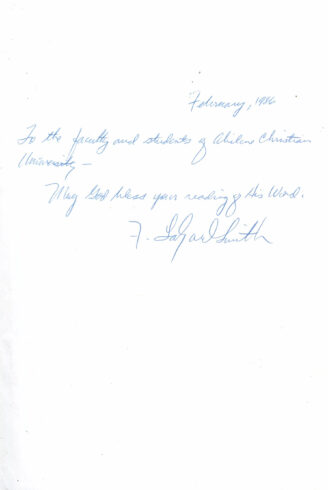
Smith, F. LaGard. The Daily Bible: New International Version with Devotional Insights to Guide You Through God’s Word. Eugene, Or: Harvest House, 1984.
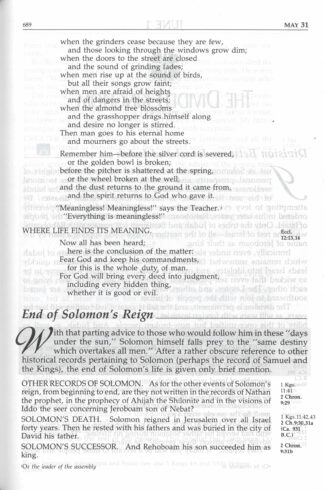
Smith, F. LaGard. The Daily Bible: New International Version with Devotional Insights to Guide You Through God’s Word. Eugene, Or: Harvest House, 1984.

Smith, F. LaGard. The Narrated Bible: In Chronological Order. Eugene, Or: Harvest House Publishers, 1984.
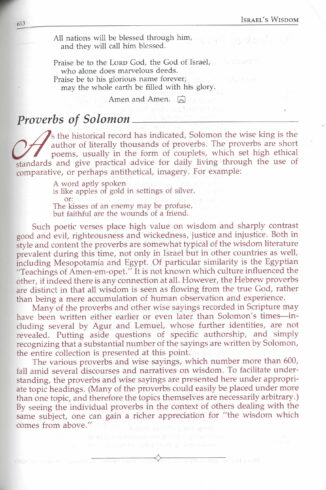
Smith, F. LaGard. The Narrated Bible: In Chronological Order. Eugene, Or: Harvest House Publishers, 1984.
Max Lucado, General Editor, Hermie & Friends Bible, 2004
Aimed at children and teens, respectively, these are based on the International Children’s Bible version and feature devotional insights by Max Lucado designed to engage young readers with the message of the Bible. Of Churches of Christ authors, LaGard Smith and Max Lucado have achieved the highest profile among general readers.

Lucado, Max. Max Lucado’s Hermie & Friends Bible: International Children’s Bible. Nashville, TN: Tommy Nelson Publishers, 2004.
Max Lucado, General Editor, Max Lucado’s Daily Devotional Bible, Everyday Encouragement for Young Readers, 2006

Lucado, Max. Max Lucado’s Daily Devotional Bible: Everyday Encouragement for Young Readers. Nashville, TN: Tommy Nelson, 2006.
Holy Bible, International Children’s Bible, 1986
When Sweet Publishing (long a supplier of curriculum and study books for Churches of Christ) issued this version, they produced for the first time a Bible designed specifically for children. By modifying the New Century Version, the translators worked directly from the latest critical Hebrew and Greek texts to produce in vocabulary, style, and composition the only translation comprehensible on a third-grade level. Displayed here are two first edition copies, one of which is open to the first chapter of Acts. ACU professors Neil Lightfoot and John Willis served on the translation team.
The New Testament, A New Easy-to-Read Version, 1978
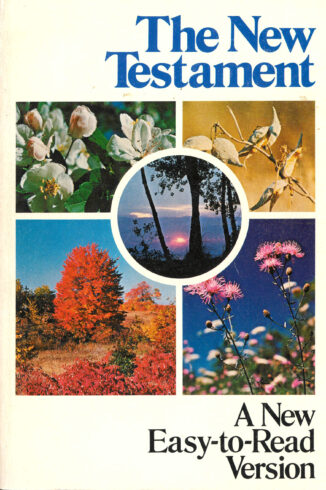
World Bible Translation Center. The New Testament: A New Easy-to-Read Version. Grand Rapids: Baker Book House, 1978.

World Bible Translation Center. The New Testament: A New Easy-to-Read Version. Grand Rapids: Baker Book House, 1978.
Hugo McCord, New Testament, McCord’s New Testament Translation of the Everlasting Gospel, 1988

McCord, Hugo. New Testament: McCord’s New Testament Translation of the Everlasting Gospel. Henderson, TN: Freed-Hardeman College, 1988.

McCord, Hugo. New Testament: McCord’s New Testament Translation of the Everlasting Gospel. Henderson, TN: Freed-Hardeman College, 1988.
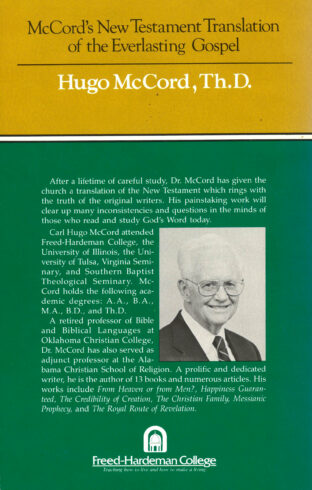
McCord, Hugo. New Testament: McCord’s New Testament Translation of the Everlasting Gospel. Henderson, TN: Freed-Hardeman College, 1988.
Harold Littrell, English Study Bible, New Testament, With Notes, 1994
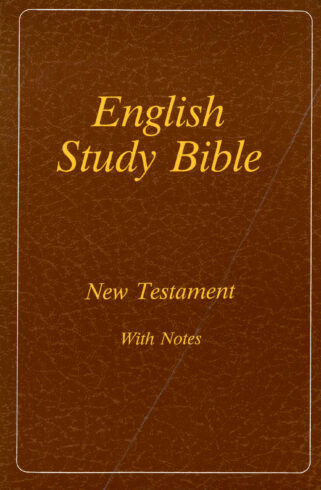
Littrell, Harold. The English Study Bible: New Testament. Ft. Worth, Tex: Star Bible Publications, 1994.
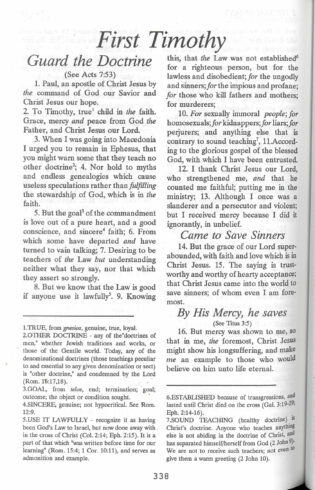
Littrell, Harold. The English Study Bible: New Testament. Ft. Worth, Tex: Star Bible Publications, 1994.
The Great Book, The New Testament in Plain English, 2003 and The New Testament: A New Easy-to-Read Version, 1981
These editions of the New Testament illustrate efforts by members of Churches of Christ to translate afresh the New Testament for a contemporary audience. McCord’s and Littrell’s are those of a single translator. The Easy-to-Read Version and The Great Book and are committee productions.
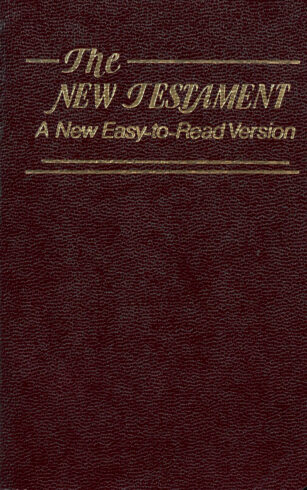
World Bible Translation Center. The New Testament: A New Easy-to-Read Version. Arlington, Tex: World Bible Translation Center, 1981.

International Bible Translators. The Great Book: The New Testament of Our Lord Jesus Christ in Plain English. Shippensburg, Pa: Destiny Image Publishers, 2003.
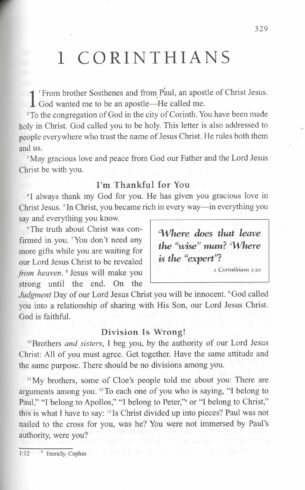
International Bible Translators. The Great Book: The New Testament of Our Lord Jesus Christ in Plain English. Shippensburg, Pa: Destiny Image Publishers, 2003.
The New King James Bible, 1982
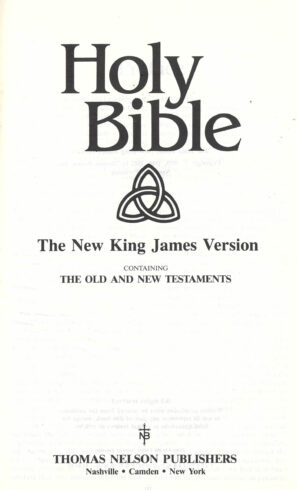
Holy Bible: The New King James Version, Containing the Old and New Testaments. Nashville: T. Nelson, 1982.
Holy Bible, New International Version, 1984
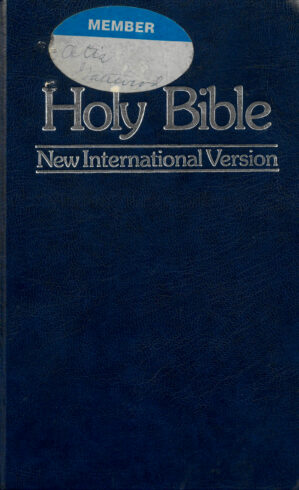
nternational Bible Society. The Holy Bible: New International Version : Containing the Old Testament and the New Testament. 1984.
HarperCollins Study Bible, New Revised Standard Version, 2008
Scholars from Disciples, Christian Churches, and Churches of Christ have participated, in varying degrees, in large-scale major, committee-based Biblical translations efforts since the 1930s.
Working on the Revised Standard Version (published in 1946 and 1952) were S. A. Weston, Stephen J. England, W. C. Morro, H. B. Robison, J. Philip Hyatt, George W. Coats, R. C. Foster, and H. Leo Boles. Working on the New International Version were Jack P. Lewis and Lewis Foster. Foster wrote the notes on Luke-Acts for the NIV Study Bible. Working on the New King James Version were Lewis Foster, Robert Hendren, and Batsell Barrett Baxter. Contributors to the HarperCollins Study Bible (using the New Revised Standard Version) were Beverly R. Gaventa, Leander Keck, Leo G. Perdue, and Robert R. Weeks. J. J. M. Roberts served on the translation team for the New Revised Standard Version. Jack Suggs edited the New Testament for the 1992 Oxford Study Bible (using the Revised English Bible).
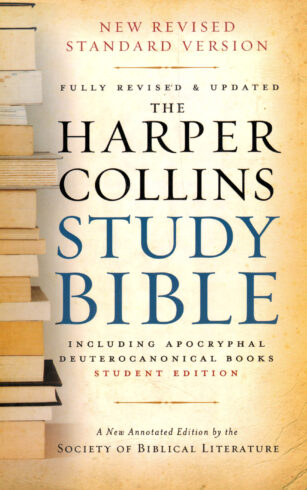
HarperCollins Study Bible, New Revised Standard Version, 2008
This exhibit was curated by Mac Ice and was on display in the ACU Library February 2020-August 2021. This digital exhibit was prepared by Amanda Dietz, December 14, 2020.
To see more exhibits from ACU Special Collections and Archives please visit our exhibit page.

